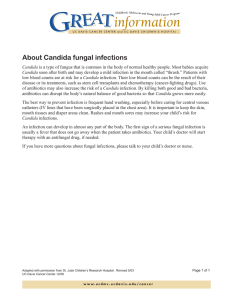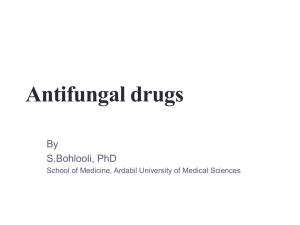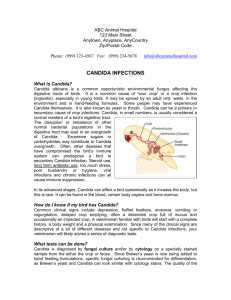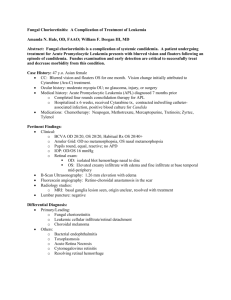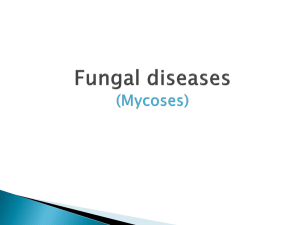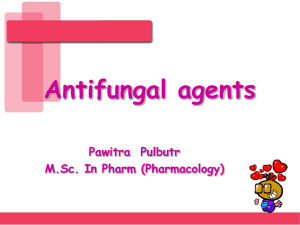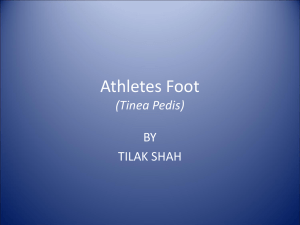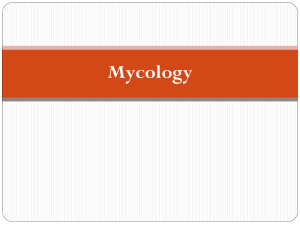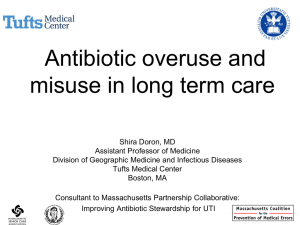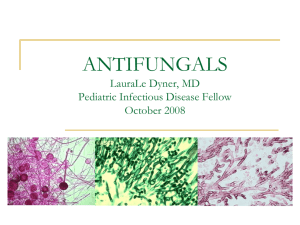Fungal Infection - Maricopa Medical Center
advertisement
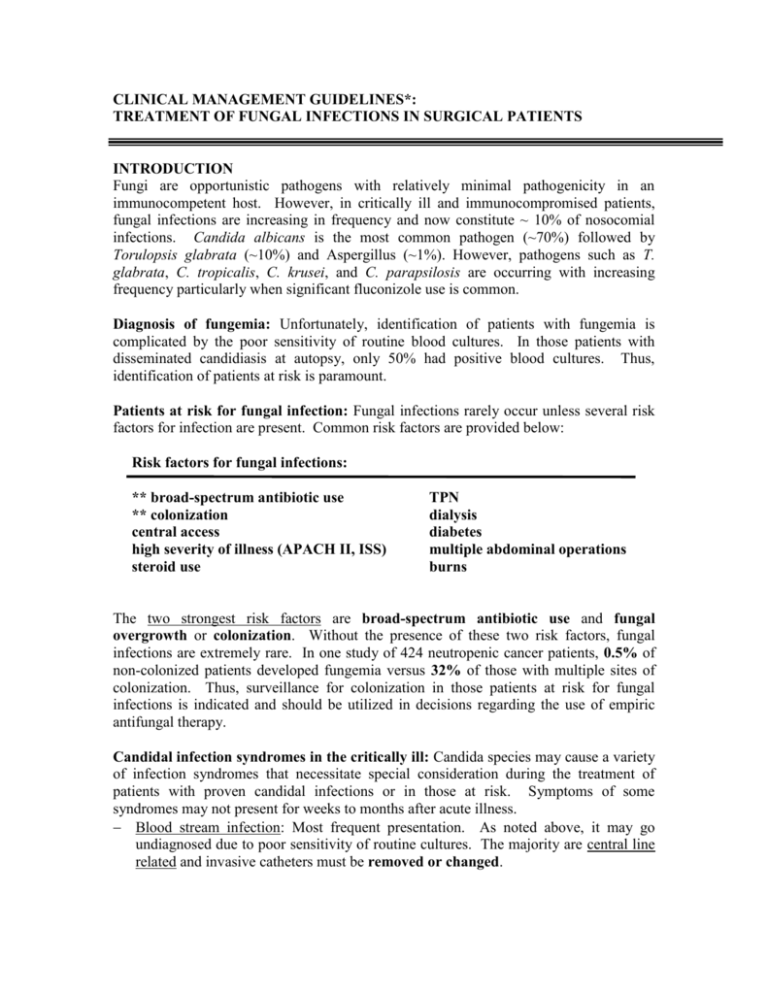
CLINICAL MANAGEMENT GUIDELINES*: TREATMENT OF FUNGAL INFECTIONS IN SURGICAL PATIENTS INTRODUCTION Fungi are opportunistic pathogens with relatively minimal pathogenicity in an immunocompetent host. However, in critically ill and immunocompromised patients, fungal infections are increasing in frequency and now constitute ~ 10% of nosocomial infections. Candida albicans is the most common pathogen (~70%) followed by Torulopsis glabrata (~10%) and Aspergillus (~1%). However, pathogens such as T. glabrata, C. tropicalis, C. krusei, and C. parapsilosis are occurring with increasing frequency particularly when significant fluconizole use is common. Diagnosis of fungemia: Unfortunately, identification of patients with fungemia is complicated by the poor sensitivity of routine blood cultures. In those patients with disseminated candidiasis at autopsy, only 50% had positive blood cultures. Thus, identification of patients at risk is paramount. Patients at risk for fungal infection: Fungal infections rarely occur unless several risk factors for infection are present. Common risk factors are provided below: Risk factors for fungal infections: ** broad-spectrum antibiotic use ** colonization central access high severity of illness (APACH II, ISS) steroid use TPN dialysis diabetes multiple abdominal operations burns The two strongest risk factors are broad-spectrum antibiotic use and fungal overgrowth or colonization. Without the presence of these two risk factors, fungal infections are extremely rare. In one study of 424 neutropenic cancer patients, 0.5% of non-colonized patients developed fungemia versus 32% of those with multiple sites of colonization. Thus, surveillance for colonization in those patients at risk for fungal infections is indicated and should be utilized in decisions regarding the use of empiric antifungal therapy. Candidal infection syndromes in the critically ill: Candida species may cause a variety of infection syndromes that necessitate special consideration during the treatment of patients with proven candidal infections or in those at risk. Symptoms of some syndromes may not present for weeks to months after acute illness. Blood stream infection: Most frequent presentation. As noted above, it may go undiagnosed due to poor sensitivity of routine cultures. The majority are central line related and invasive catheters must be removed or changed. Septic thrombophlebitis and endocarditis: Candida species are very thrombogenic and avidly adher to the subendothelial, extracellular matrix. Thus, candida has a propensity to induce septic thrombophlebitis and endocarditis in the presence of valvular endothelial injury. Persistently positive blood cultures mandate work up for these syndromes. The presence of venous thrombosis with fungemia, positive catheter cultures, or with multiply colonized sites should be presumed to have thrombophlebitis and treated with anticoagulation and antifungal therapy. Intraabdomial infection: Candida is one of the four most common pathogens in tertiary peritoneal or recurrent intraabdominal infections. Thus, patients with multiple abdominal procedures or with recurrent/tertiary peritoneal infections should be treated with antifungal therapy. Endophthalmitis: Patients with fungemia may develop endophthalmitis. Patients with fungemia or those at high risk undergoing evaluation for possible fungal infection should undergo ophthalmologic examination. Disseminated candidiasis: Candida species have a propensity for hematogenous spread to remote organs/sites. Symptoms may not present for weeks to month and may be a source of fever of unknown origin. Candidurea: Patients with candida in urine most frequently have bladder colonization. Candida adheres to the catheter and this should be changed. Symptomatic patients can be treated with fluconazole for 2-5 days. Patients with acute renal failure require bladder irrigation with amphotericin B. THERAPEUTIC CONSIDERATIONS Medication options: Four agents are considered in the treatment of patients with systemic fungal infections. Fluconazole is efficacious against most Candida species. However, rising MIC’s can develop and are more common with low dose therapy. Treatment of systemic infections should generally consist of 800 mg followed by 400 mg/day. During severe illness continuing the 800 mg/day dosing should be considered. Amphotericin is a very effective agent but has significant toxicities. Infusion related reactions include hypotension, fever, and tachycardia and dosing should be preceded by a 1 mg test dose followed by infusion over 4 hours. Premedication with hydrocortisone, demerol and benadryl can minimize changes in symptomatic patients. Nephrotoxicity can develop in up to 30% of patients. Usually less severe at lower dosing and can minimized by Na+ loading with 500 cc NS before and after dosing. Other nephrotoxic agents should be avoided if possible. Dosing: Candida species /stable 0.5-0.7 mg/kg/day to total of 6-8 mg/kg Candida species/unstable 0.8-1.0 mg/kg/day to total of 10 mg/kg Aspergillus 1.0-1.5 mg/kg/day to total of 10-30 mg/kg Liposomal amphotericin (Ambisome) somewhat less potent but marked reduction in nephrotoxicicty that allows much higher dosing. Very expensive: 70 mg ampho B = $6.32/day. 210 mg of ambisome = $520.80/day. Dosing: Candida species 2-3 mg/kg/day Aspergillus 5-10 mg/kg/day Fluycytosine is an effective antifungal agent but resistance develops when used alone. Myelosuppression can develop, particularly at higher dosing and serum concentrations should be monitored. Candida species typically respond to lower dosing. Dosing: Candida species 12.5 mg/kg Aspergillus 37.5 mg/kg Pathogens and Susceptibilities: Candida albicans, tropicalis, and parapsilosis are all usually sensitive to both fluconazole and amphotericin. However, increasing MIC’s have been reported to both agents, although more commonly with fluconazole. Resistance generally develops with long term or low dose exposure. Resistance should be considered in the setting of clinical failure or infection that develops during the use of an agent. Candida krusei is intrinsically resistant to fluconizole and should be treated with amphotericin. Torulopsis glabrata is less sensitive to both fluconizole and amphotericin than the candida species. Many cases can be successfully treated with high dose fluconizole but some strains are highly resistant to fluconizole. Treatment with amphotericin should utilize a higher dosing range than the Candida species. Candida lusitaniae may develop resistance to both agents and sensitivities should be obtained. Treatment with amphotericin and flucytosine should be started until sensitivities are obtained. Aspergillus is resistant to fluconazole. Amphotericin (or liposomal amphotericin) is the drug of choice but requires significantly higher dosing than Candida species. Therapeutic indications – empiric, presumptive, and prophylactic indications: Empiric therapy - high risk patients with suspicion of infection but no positive cultures establishing systemic or deep infection. In general, patients without colonization are at very low risk of fungal infection. Thus, generally limit treatment to those with multiple sites of colonization or at high risk with single site failing antibacterial therapy. Patients with tertiary peritoneal infections have a high likelihood of peritoneal fungal infection and should be treated with antifungal therapy until cultures prove otherwise. Presumptive therapy – patients with positive cultures for systemic or deep fungal infection but organism identification still pending. Candida albicans remains the most common pathogen in surgical patients and can be assumed to be sensitive to fluconizole except when infection develops during or after significant fluconizole use. Thus, fluconizole should be the first choice. Patients that have received fluconizole prior to developing a fungal infection are at high risk of having species that are either tolerant or resistant to fluconazole and should be treated with amphotericin. In unstable patients, amphotericin should be considered since resistance to it is less than with fluconizole. Prophylatic therapy – prophylactic therapy can be effective in certain very high risk patients. However, prolonged antifungal use strongly selects for resistant organisms. Thus, prophylaxis should be limited to those considered at high risk who also have one or more sites of colonization or repeated abdominal operations and therapy can be limited to brief episodes. *Clinical Management Guidelines (CMG) have been developed by the Section of Trauma, Burns and Surgical Critical Care in an attempt to standardize and optimize care. They are based on a combination of accepted surgical practice and recent contributions to the medical literature. CMGs are intended to provide guidelines for the management of the majority of patients, and are not proposed as rules, policies or as a substitute for clinical judgment. Deviations from the CMGs are necessary and expected; all exceptions should be documented in the medical record and discussed with the attending physician.
